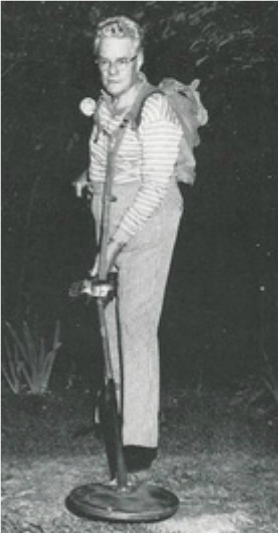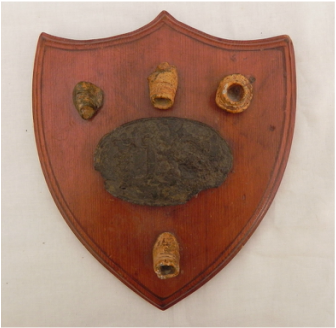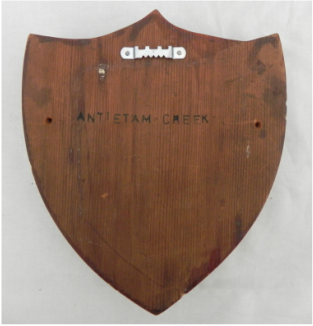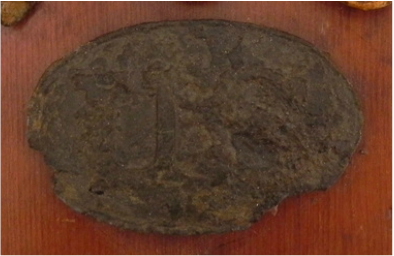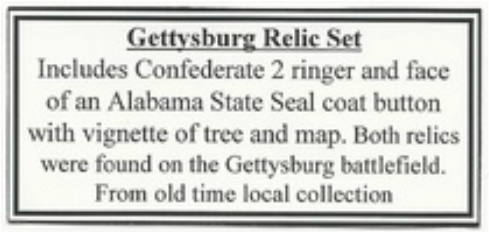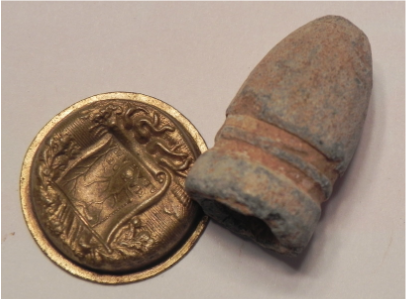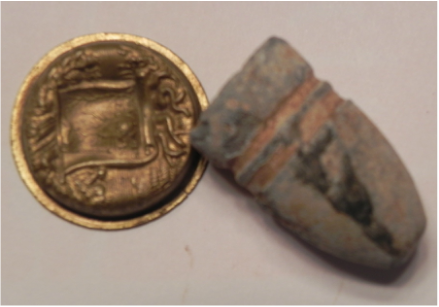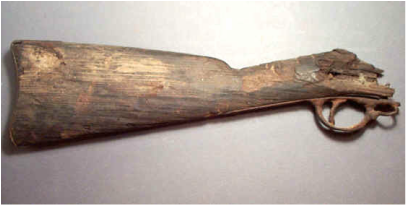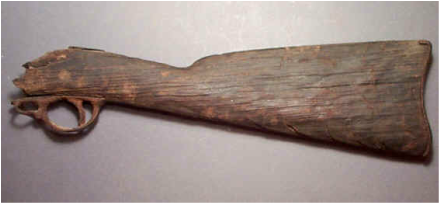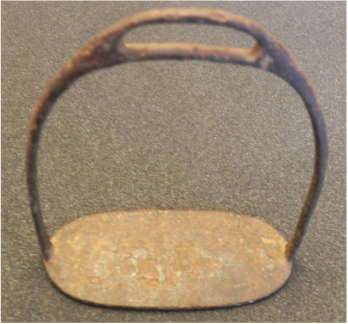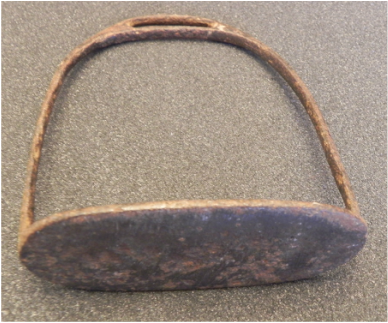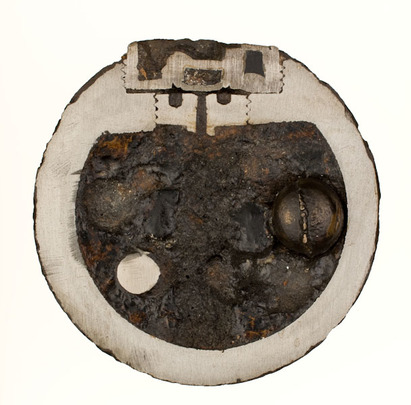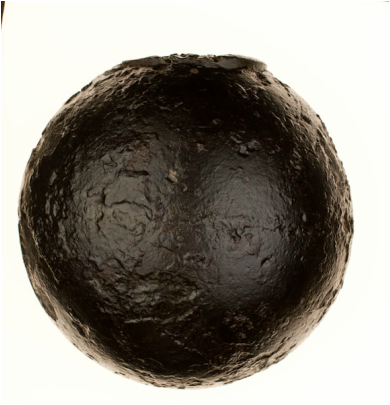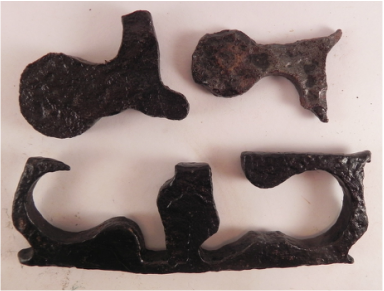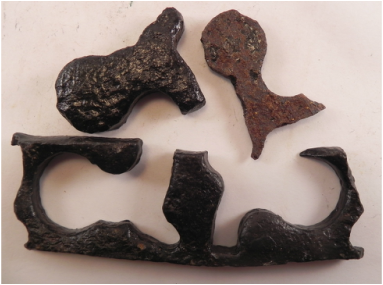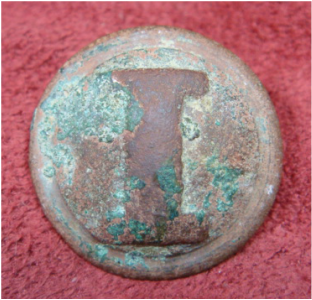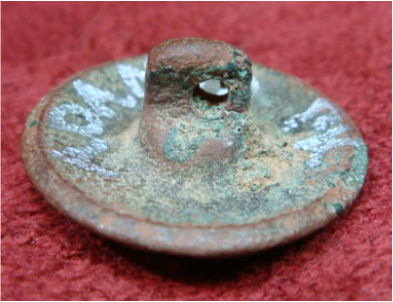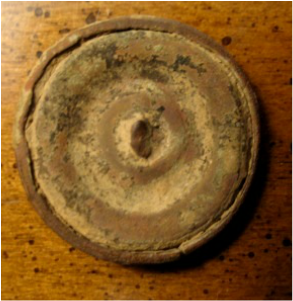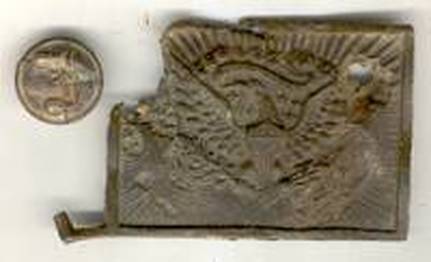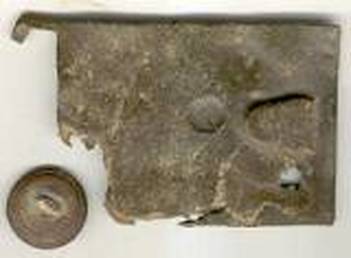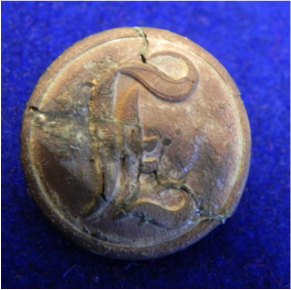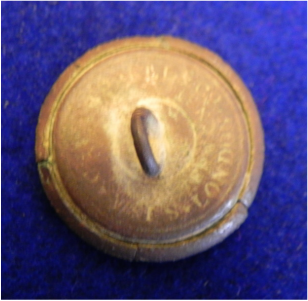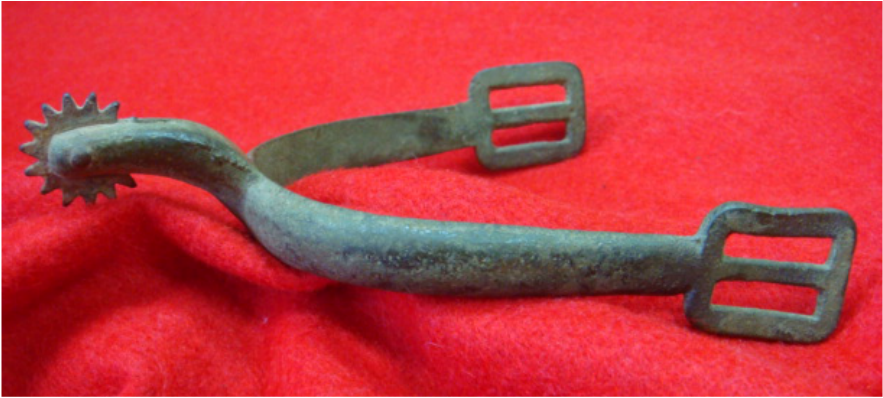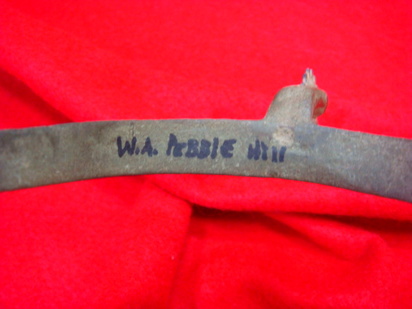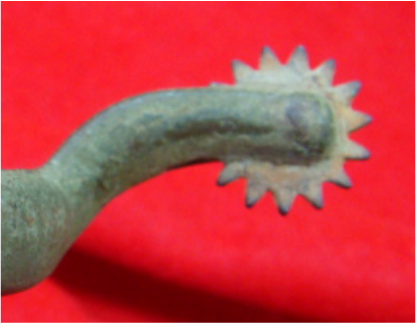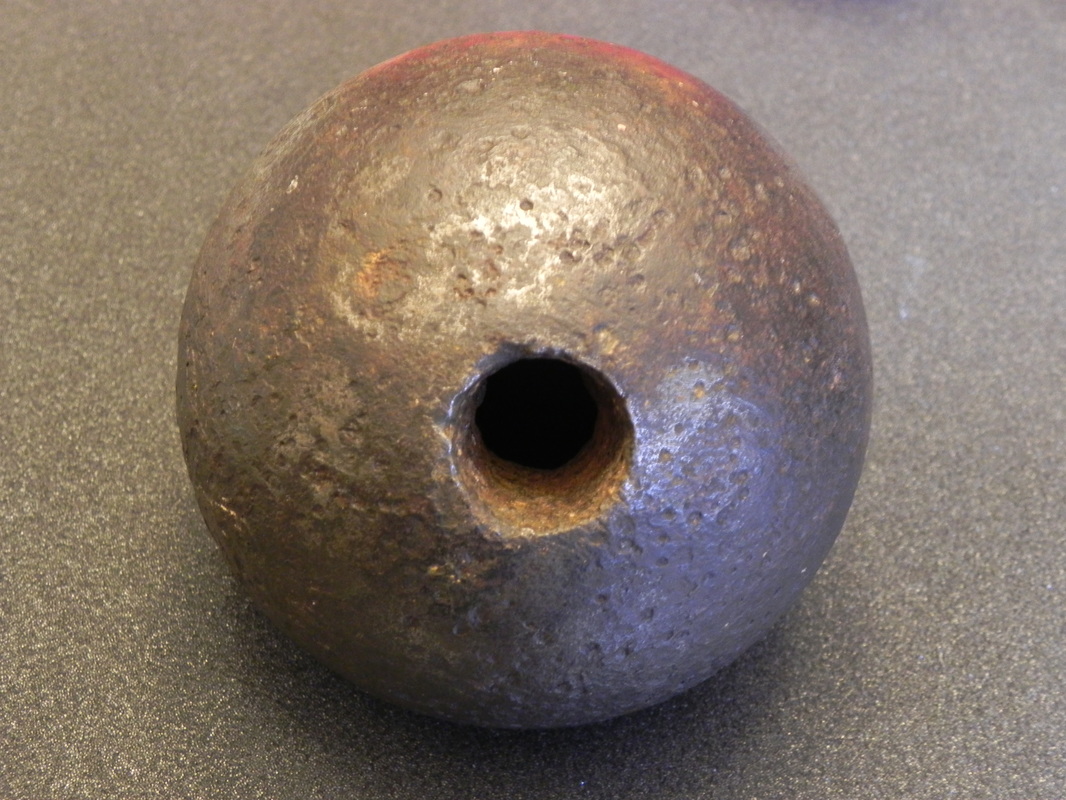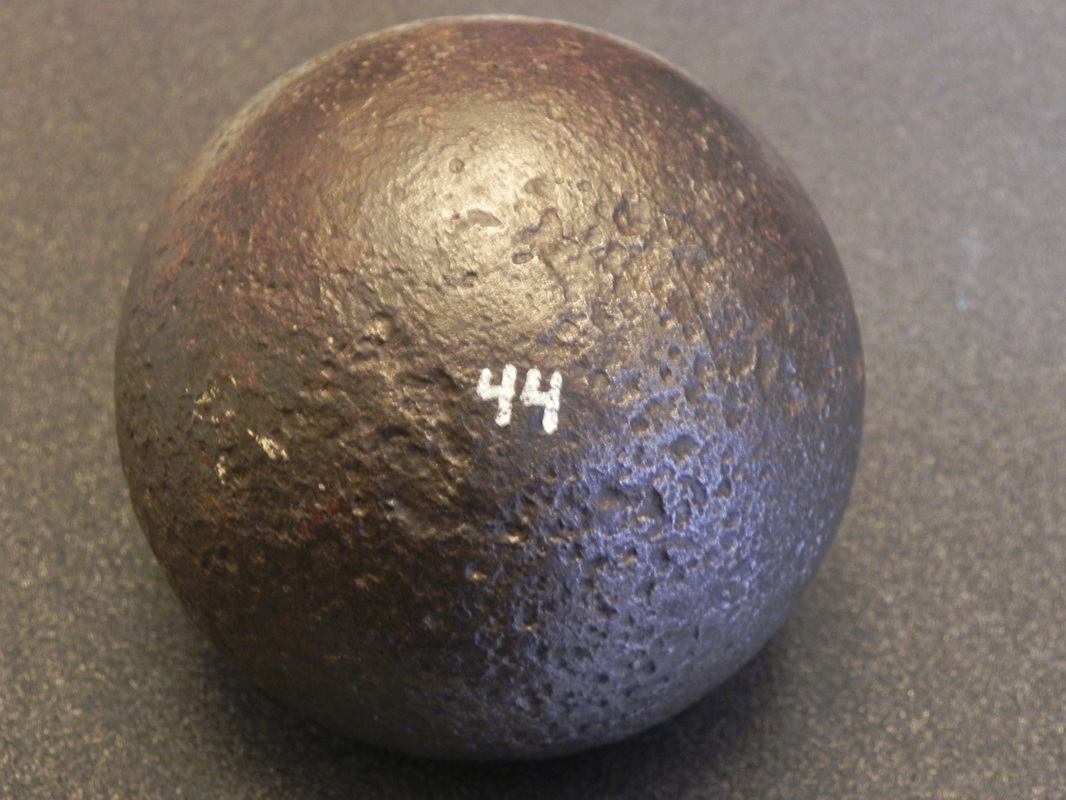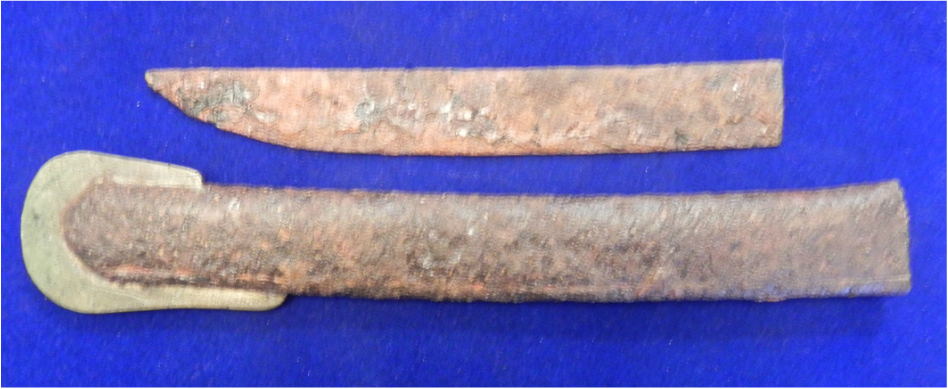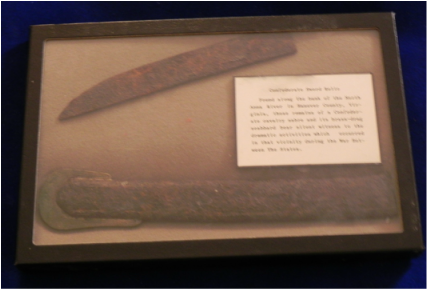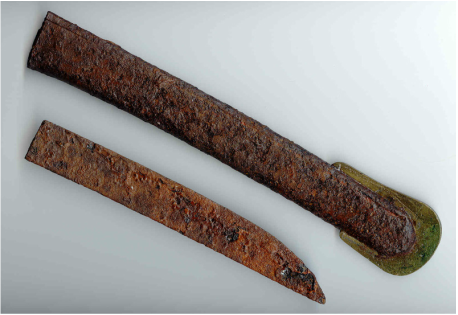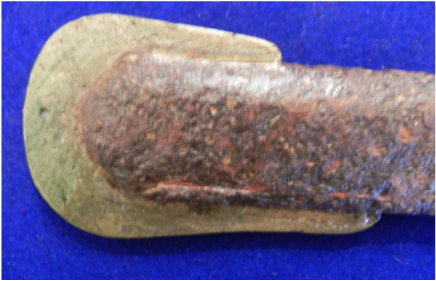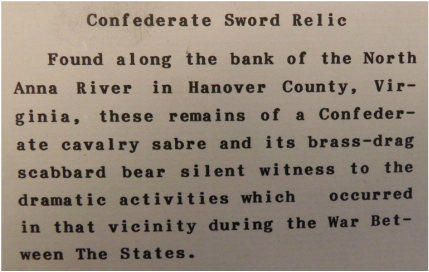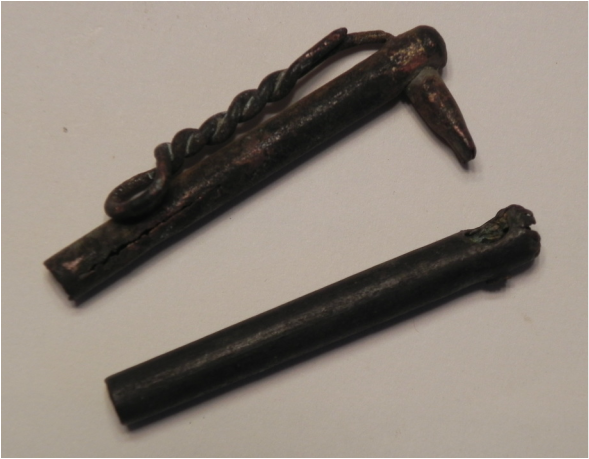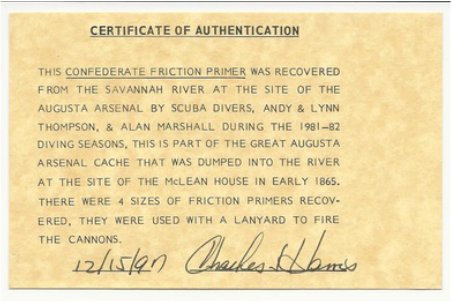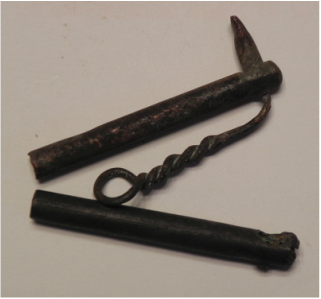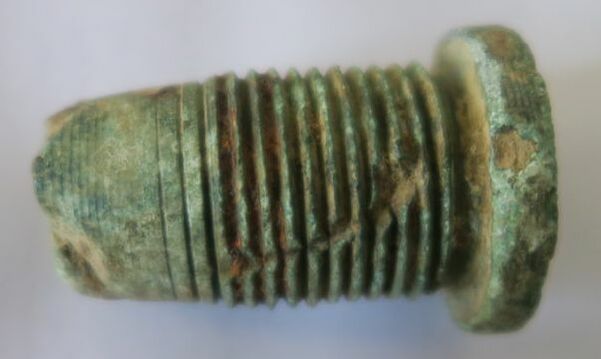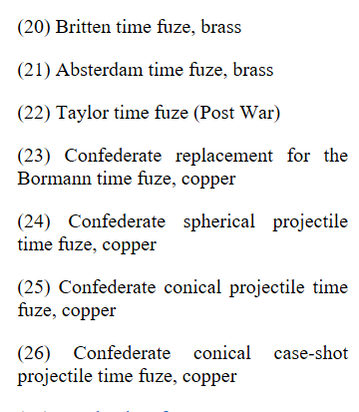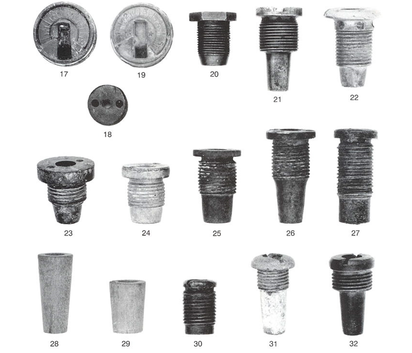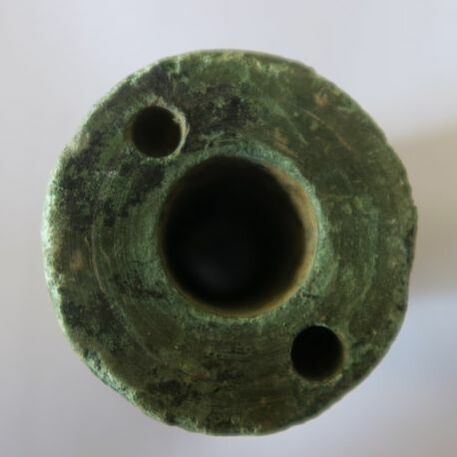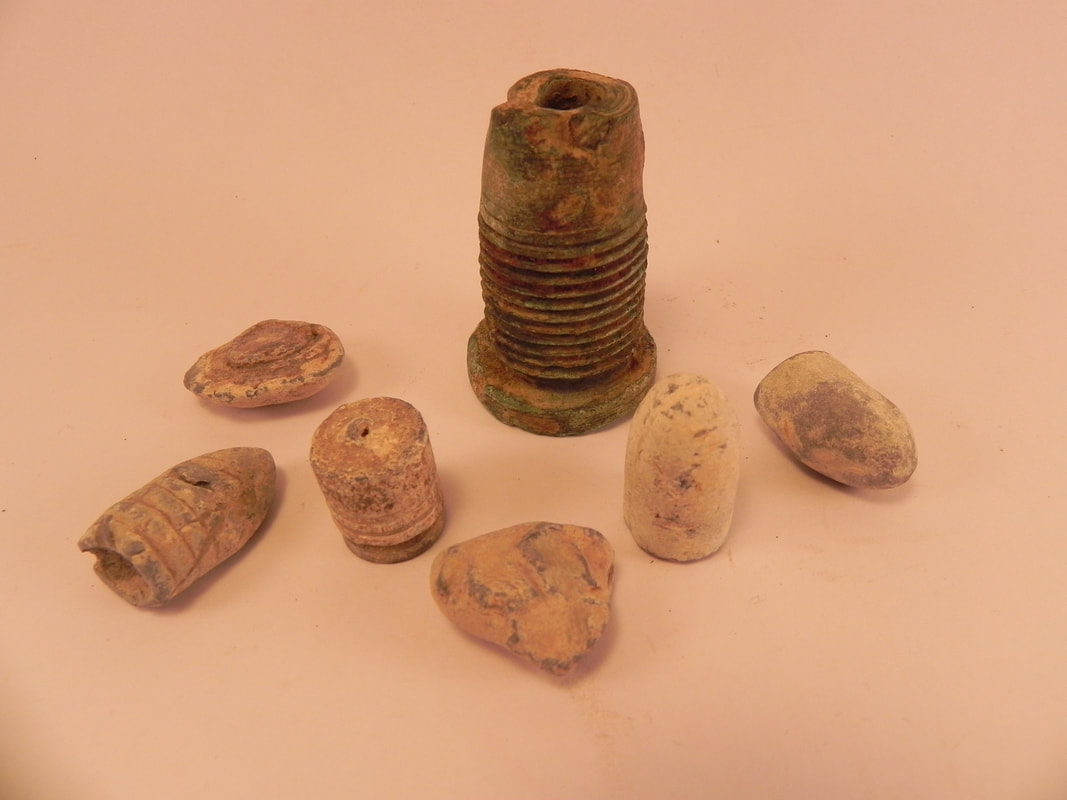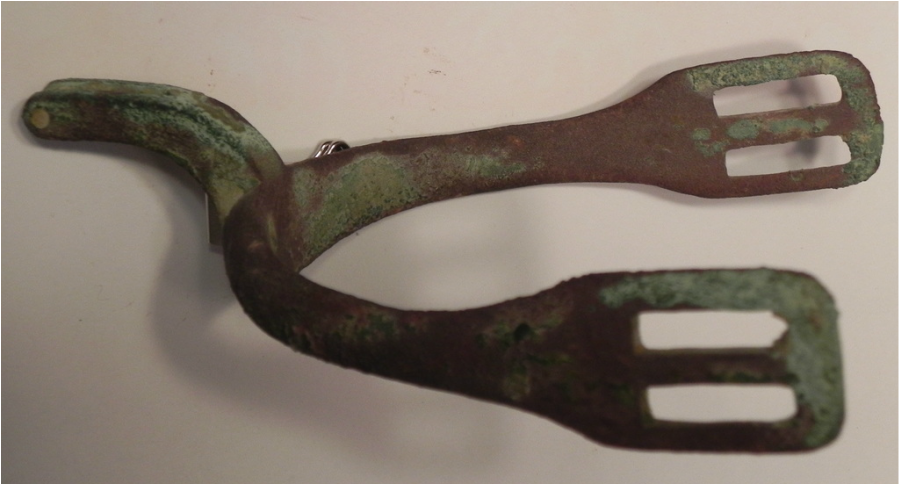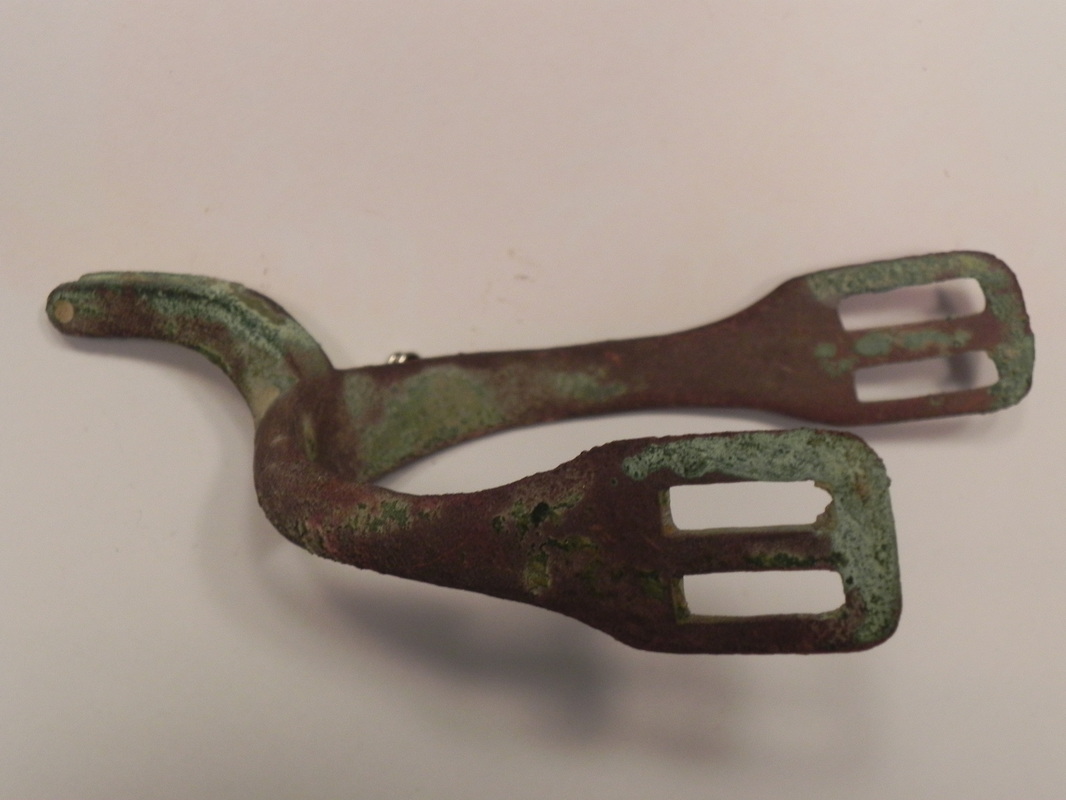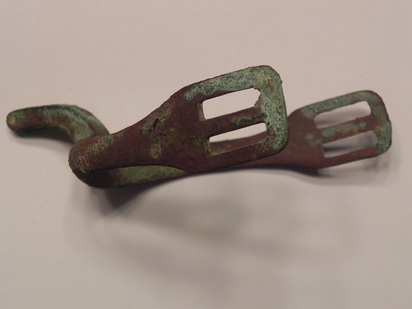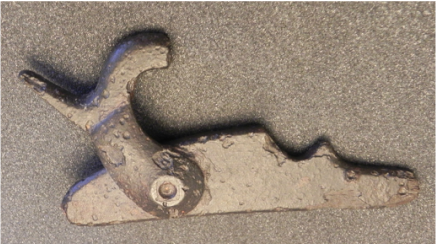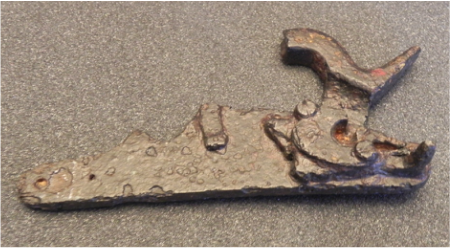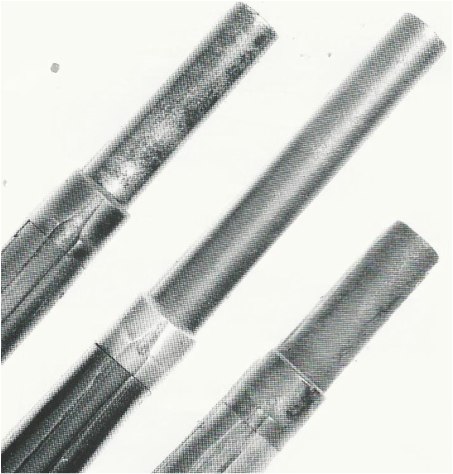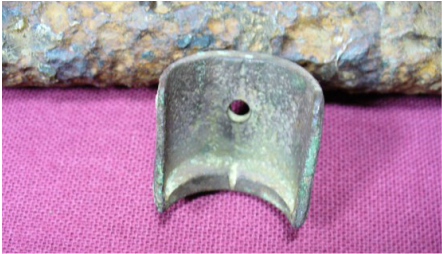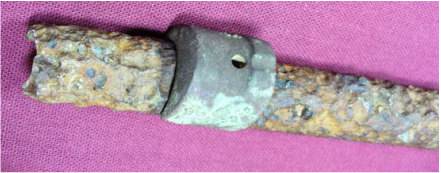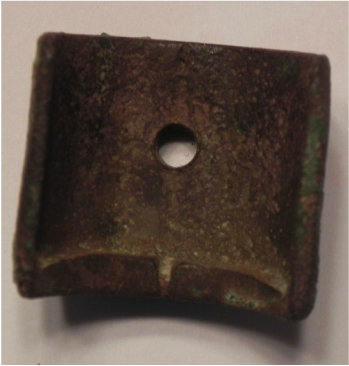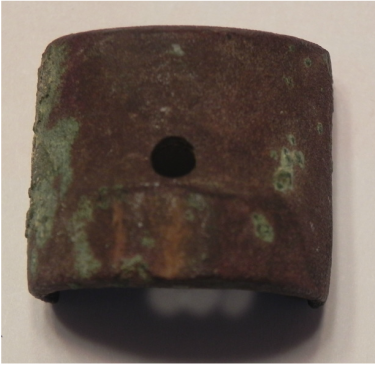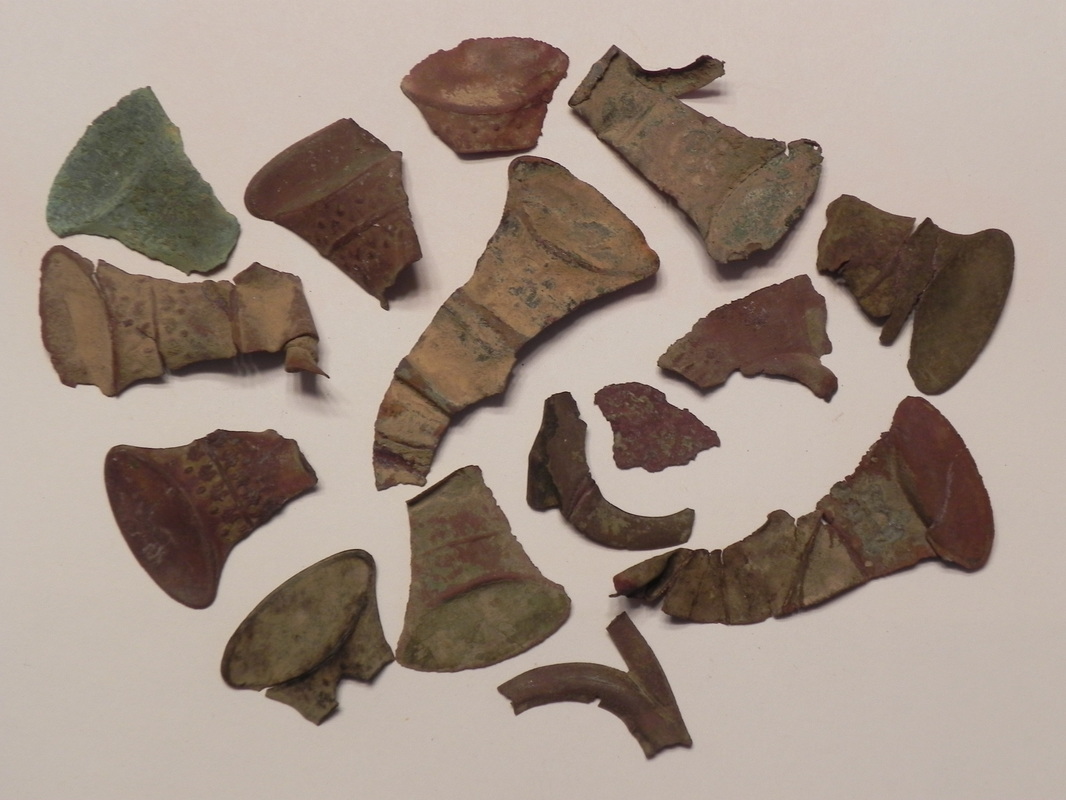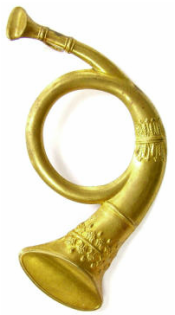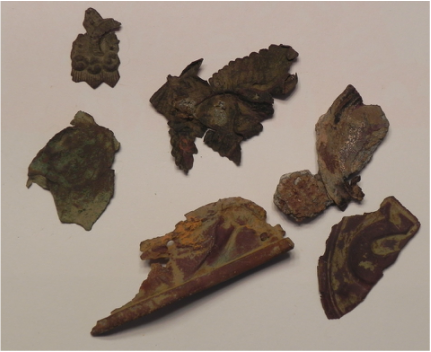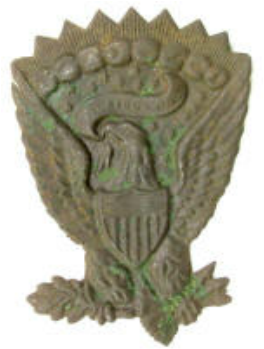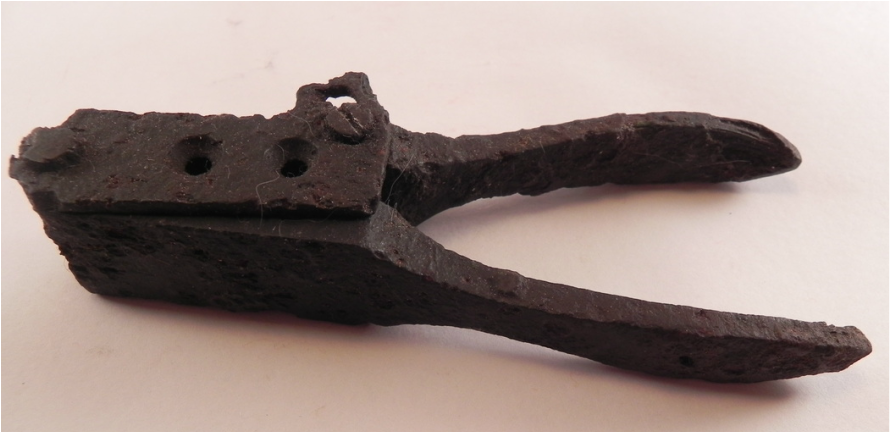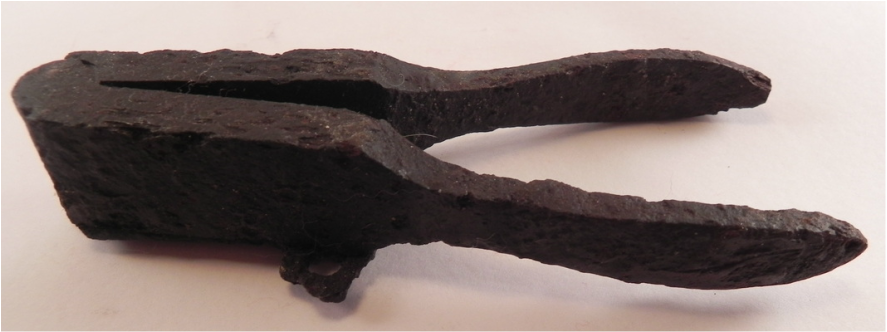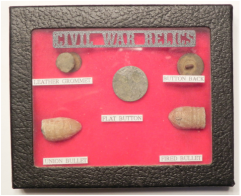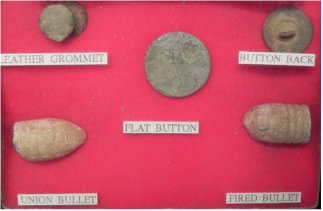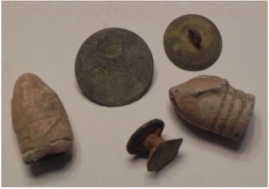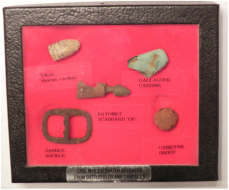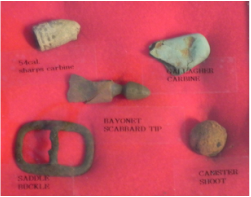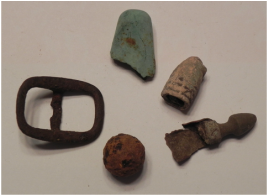Dug Items
MR. BEVERLY DUBOIS, PIONEER RELIC HUNTER
EARLY ANTIETAM DISPLAY PLAQUE
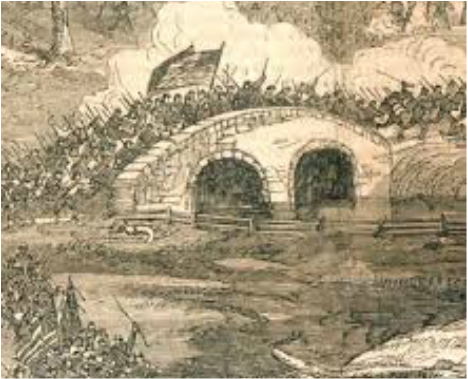 BURNSIDE BRIDGE AT ANTIETAM
BURNSIDE BRIDGE AT ANTIETAM
This relic board is a wood carved shield Circa 1930's. The words "Antietem Creek" are stamped on the back . The display consists of four minie balls and a U.S. buckle. The relics are glued to the board which was the custom at the time. This item was purchased from The Horse Soldier of Gettysburg and came from a large Gettysburg/Antietem collection from Maryland. Nice relics from a famous Civil War battlefield but also a good representation of the early days of relic dispalys.
"The Army of the Potomac, under the command of George McClellan, mounted a series of powerful assaults against Robert E. Lee’s forces near Sharpsburg, Maryland, on September 17, 1862. The morning assault and vicious Confederate counterattacks swept back and forth through Miller’s Cornfield and the West Woods. Later, towards the center of the battlefield, Union assaults against the Sunken Road pierced the Confederate center after a terrible struggle. Late in the day, the third and final major assault by the Union army pushed over a bullet-strewn stone bridge at Antietam Creek. Just as the Federal forces began to collapse the Confederate right, the timely arrival of A.P. Hill’s division from Harpers Ferry helped to drive the Army of the Potomac back once more. The bloodiest single day in American military history ended in a draw, but the Confederate retreat gave Abraham Lincoln the “victory” he desired before issuing the Emancipation Proclamation."
(Reference: very nice examples of relic displays in chgapter five of Mike O'Donnell's book " Gettysburg Battlefield Relics and Souvenirs".)
BUTTON/BULLET
Please be careful when purchasing any artifact. I purchased the above button and dropped 3 ringer at a shop in Gettysburg in my early days of collecting. This the only time I purchased items based on the story.
MODEL 1861 MUSKET BARRELL RECOVERED FROM THE JAMES RIVER
Interesting remains of an 1861 musket, recovered from the James River. This is in nice relic condition. The dug musket barrel with sight is straight and complete with one band still clinging to the barrel and the second has broken off of the barrel and is in two pieces. There are remains of wood on the barrel and the nose guard is present.
(Reference "The Illustrated History of American Civil War Relics" by Stephen W. Sylvia & J. O'Donnell, page 198; "Civil War Artifacts A Guide to The Historian" by Howard Crouch, pages 84,85, 87 "Civil War Relics of the Western Campaigns" by Charles S. Harris, page 86; The U.S. Model 1861 Springfield Rifle-Musket 2nd Edition by James B. Whisker, Daniel D. Hartzler and Larry W. Yanz, pages Introduction to page 38)
(Reference "The Illustrated History of American Civil War Relics" by Stephen W. Sylvia & J. O'Donnell, page 198; "Civil War Artifacts A Guide to The Historian" by Howard Crouch, pages 84,85, 87 "Civil War Relics of the Western Campaigns" by Charles S. Harris, page 86; The U.S. Model 1861 Springfield Rifle-Musket 2nd Edition by James B. Whisker, Daniel D. Hartzler and Larry W. Yanz, pages Introduction to page 38)
MODEL 1861 MUSKET BUTT RECOVERED FROM THE JAMES RIVER
The model 1861 musket artifact was recovered from the James River. It consists of the trigger guard and most of the wood from around the trigger to the butt. I don't know if this and the barrel above were found together but were both lost in the many crossings over the James River near Virginia. I had purchased a model 1861 lock plate and when displayed with the butt and barrel (above) comes close to making up a complete musket.
(Reference "The Illustrated History of American Civil War Relics" by Stephen W. Sylvia & J. O'Donnell, page 198; "Civil War Artifacts A Guide to The Historian" by Howard Crouch, pages 84,85, 87; "Civil War Relics of the Western Campaigns" by Charles S. Harris, page 86;(above) The U.S. Model 1861 Springfield Rifle-Musket 2nd Edition by James B. Whisker, Daniel D. Hartzler and Larry W. Yanz, pages Introduction to page 38)
(Reference "The Illustrated History of American Civil War Relics" by Stephen W. Sylvia & J. O'Donnell, page 198; "Civil War Artifacts A Guide to The Historian" by Howard Crouch, pages 84,85, 87; "Civil War Relics of the Western Campaigns" by Charles S. Harris, page 86;(above) The U.S. Model 1861 Springfield Rifle-Musket 2nd Edition by James B. Whisker, Daniel D. Hartzler and Larry W. Yanz, pages Introduction to page 38)
CIVIL WAR SADDLE STIRRUP
This is a Civil War era stirrup that Lawrence Christopher from Georgia threw in with another purchase I made. No maker, no provenance, but displays nicely in a cavalry collection as a relic of the war.
(Reference; "Civil War Artifacts, A Guide to The Historian" by Howard R. Crouch, page 137; "Excavated Artifacts for Battlefields and Campsites of the Civil War 1861-1865" by Stanley S. Phillips pages 77-78)
(Reference; "Civil War Artifacts, A Guide to The Historian" by Howard R. Crouch, page 137; "Excavated Artifacts for Battlefields and Campsites of the Civil War 1861-1865" by Stanley S. Phillips pages 77-78)
CONFEDERATE BORMAN SHELL
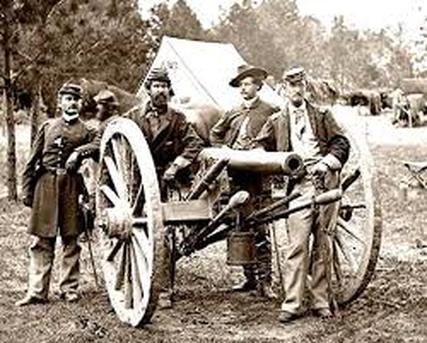
This dissected Confederate 6 lb Bormann shell shows a nice under plug along with case shot and matrix. The shell split apart after being 99% cut, leaving a complete case shot extruding out. The recovery site is unknown. The iron is in overall good condition. This particular shell was previously owned by Dr. Lawrence E. Pawl, co-author of "Melton & Pawl's Guide to Civil War Artillery Projectiles".
(Reference: Dickey & George, Field Artillery (1993 Edition), pg. 35; "Civil War Artifacts A Guide to The Historian" by Howard Crouch, page 110; "Civil War Relics of the Western Campaigns" by Charles S. Harris, page 82)
GRISWOLD REMNANTS OF SHERMAN'S MARCH
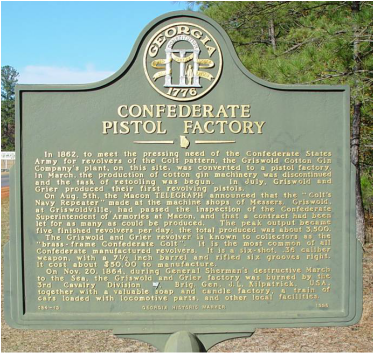
The Griswold and Gunnison revolver, known simply as the Griswold, became one of the most famous firearms made for the Confederate Army and today is one of the rarest. Few handgun makers in the south equaled the Griswold in quality and none exceeded its production, even though Griswold and Gunnison made only 3,700 revolves. At the start of the Civil War, the Confederacy found itself at a distinct disadvantage since almost all of the large firearm manufacturing plants were located in the northeast part of the country. Not only were those plants in Union territory, but the large steel mills were also there. The Confederacy offered interest-free loans and other incentives to anyone willing to set up firearm manufacturing operations in the south to supply the Confederate Army with the weapons it needed. Samuel Griswold and Arvin Gunnison decided to respond to the offer. Griswold had moved from Connecticut to Clinton, Georgia in 1820 and established the first iron foundry in Georgia. He had additionally started the Griswold Cotton Gin Company in Clinton that had grown into one of the largest producers of cotton gins in the country. He moved his foundry and cotton gin factory to land he had purchased to be close to the railroad and, in addition to the foundry and cotton gin factory, he built a sawmill, gristmill, and soap and candle factory. Together with his own home and a few others in the area, he established the village of Griswoldville, Georgia near Macon, Georgia. According to the noted Confederate arms historian, William A. Albaugh, III, Griswold decided in 1862 to convert his cotton gin factory into a pistol factory knowing that his cotton gin would not be in demand during the war. Arvin Gunnison had begun manufacturing pistols in New Orleans but left the city as Union forces moved towards and captured the city in the spring of 1862. He moved his pistol manufacturing operations to Griswoldville to join Griswold who was planning to obtain a contract to supply the Confederacy with revolvers. In July of 1862, they began producing their first "Confederate brass-framed Colts," the name originally given their handgun. In August, they passed inspection by the Confederacy and were given a contract to produce as many revolvers as possible. They were only one of three southern manufacturers to take advantage of the Confederacy contract, but they were the most successful. The Griswold copied the Colt 1951 Navy model. Like the Navy Colt, the Griswold featured a 36 caliber, 6-shot round cylinder, percussion cap and ball revolver and had a Dragoon type 7½-inch barrel with six twisting grooves. The barrel was part octagonal and part round at the muzzle whereas the entire barrel of the Navy Colt was octagonal. Largely due to the steel shortage in the south, the Griswold had a brass frame and trigger guard as opposed to Colt’s case hardened steel. Griswold and Gunnison, like other Confederate firearm manufacturers, had to use whatever metal became available to them. Brass was almost equally hard to acquire. Albaugh further describes the patriotic appeal made by the Confederacy to local churches which were asked to "loan" their church bells to the Confederacy, and churches did so knowing that their bells would be melted down to make guns for the Confederate Army. In most cases, the Griswold “brass” is actually steel with a high copper content that gives the frame a rose tint. Typically, the Griswold cylinder was made of twisted iron instead of steel since twisting the heated iron bars strengthened the iron. The twist lines on the cylinder help identify the revolver. The cylinder had six safety pins compared to one in the Navy Colt. The cylinder was not blued to inhibit rust, however, and the iron in the cylinder did rust. It can be finally noted that the Griswold was manufactured in two models: the first had a round barrel housing while the housing on the later second model was octagonal. Union forces destroyed the Griswold and Gunnison pistol plant in November 1864 during the first battle of Sherman’s march to the sea. It was a short, spirited fight for a lost cause at the "Battle of Griswold" with old men from the Georgia State Guard and young boys from a local military school. Sherman's army captured and destroyed the factory. In its day it was one of the South's finest factories but today is nothing more than a crossroads going over the railway tracks. Griswold and Gunnison started over again but with a much smaller operation that continued until April 1965. Within the debris were these relics of the factory's Griswold revolver. Included above are two unfinished hammers and a piece that contain the "blanks" for two hammers.Many other parts and pieces were found at the site of the ruins, including cylinders, barrels, frames and almost completely assembled weapons. These are pieces from one of the rarest Confederate-made weapons.....see a complete Griswold revolver in the antique weapons section.
Reference: "Civil War Relics of the Western Campaigns" by Charles S. Harris, page 245; " Confederate Arms" by illiam A. Albaugh lll and Edward N. Simmons, page 10; "The Confederate Brass-Framed Colt & Whitney" by William A. Albaugh III, page 8)
Reference: "Civil War Relics of the Western Campaigns" by Charles S. Harris, page 245; " Confederate Arms" by illiam A. Albaugh lll and Edward N. Simmons, page 10; "The Confederate Brass-Framed Colt & Whitney" by William A. Albaugh III, page 8)
CS DUG CAST "I" BUTTON
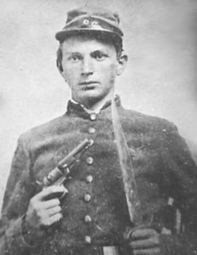 CONFEDERATE JOHN R. LANGSTON
CONFEDERATE JOHN R. LANGSTON
A very nice Cast "I" button with the beautiful patina so common from the soils of the area in which it was found. The "I" stands out very nicely. Painted on the back is " ADAMS" and "RK" or "AK". I haven't made any effort to figure out the relevance of the name. It came out of a larger collection purchased in Tennessee. This is the brass convex one piece cast "I" Infantry button with a border and roman "I". Brass . Blank. measures 23 mm. No other button represents the "common" Confederate soldier than a cast-brass "I" Infantryman's button.
Reference; Civil War Artifacts, A Guide to The Historian by Howard R. Crouch, page 180, 161; "Civil War Relics of the Western Campaigns" by Charles S. Harris, page 198, 208; " Confederate Arms" by William A. Albaugh lll and Edward N. Simmons, page 167;Record of American Uniform and Historical Buttons with Supplement by Alphaeus H. Albert, page 366-CS 184)
Reference; Civil War Artifacts, A Guide to The Historian by Howard R. Crouch, page 180, 161; "Civil War Relics of the Western Campaigns" by Charles S. Harris, page 198, 208; " Confederate Arms" by William A. Albaugh lll and Edward N. Simmons, page 167;Record of American Uniform and Historical Buttons with Supplement by Alphaeus H. Albert, page 366-CS 184)
MISSISSIPPI "I" BUTTON
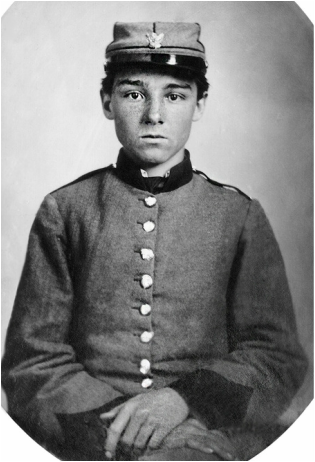 CONFEDERATE ARMY PRIVATE EDWIN FRANCIS JEMISON
CONFEDERATE ARMY PRIVATE EDWIN FRANCIS JEMISON
Excavated Mississippi "I" Infantryman's coat button from Brig. General Jones Mississippi Brigade Assault at Perryville, Kentucky, October 8th, 1862. This is the 2 piece with the letter I on star and Mississippi encircling. Blank, a Confederate local. 21 mm. This would have come from one of the three MS Regiments,; 27th MS, 30 MS or 37th MS Infantry Regiments from their attack to the "Bloody Sinkhole". This coat-sized button button was excavated decades ago by a local Kentucky relic hunter. The land was in private hands until eventually acquired by the state of Kentucky for the state battlefield park, so you won't be seeing any more of these being dug these days. The button shows the details beautifully, the "MISSISSIPPI" and the "I" within the star are all clearly and crisply seen. Minute gold gilt traces can be detected in hints around the star and lettering and some Perryville bloodied soil still encrusts this button. It has a push in the face, a hairline crack off to one edge, and is missing the shank. One can certainly appreciate how this battle relic, off a poor Mississippi boy far from home and in the storm of battle that day in the Bluegrass, many not be perfect. But it's history with the great displaying face makes this button so appealing.
(Reference; Civil War Artifacts, A Guide to The Historian by Howard R. Crouch, page 182; 49, 146;"Civil War Relics of the Western Campaigns" by Charles S. Harris, page 146; " Confederate Arms" by William A. Albaugh lll and Edward N. Simmons, page 166; Record of American Uniform and Historical Buttons with Supplement by Alphaeus H. Albert, page 185-MP8)
(Reference; Civil War Artifacts, A Guide to The Historian by Howard R. Crouch, page 182; 49, 146;"Civil War Relics of the Western Campaigns" by Charles S. Harris, page 146; " Confederate Arms" by William A. Albaugh lll and Edward N. Simmons, page 166; Record of American Uniform and Historical Buttons with Supplement by Alphaeus H. Albert, page 185-MP8)
US SWORD BELT PLATE & CS SCRIPT "I" BUTTON DUG TOGETHER
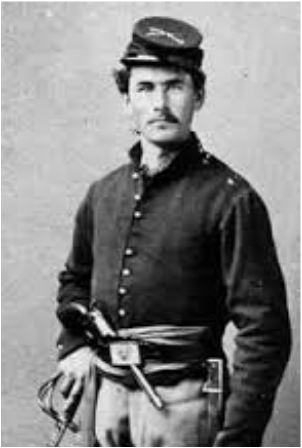
Excavated Officer's sword belt plate found in a fire pit at Bridgeport, Ala. Out of the same pit came this Confederate old English I button with the Isaacs Campbell & Co./London/ 71 Jermyn St. back mark. It measures 22 mm. The button has the intact shank but the face has a crack. The button is the two piece Infantry with border. A lined old English "I". I purchased this from Lawrence Christopher.
(Reference: (buckle) "American Military Belt Buckles" by Michael J. O'Connell and J. Duncan Campbell, plate; "Accoutrement Plates North and South 1861-1865" by William G. Gavin, page 18; "Civil War Collector's Encyclopedia", Volume IV, by Francis A. Lord, , page 6 ; "Civil War Artifacts A Guide to The Historian" by Howard Crouch, page 180; "Civil War Relics of the Western Campaigns" by Charles S. Harris, page 161, 202; " Confederate Arms" by William A. Albaugh lll and Edward N. Simmons, page 167)
(Button) Record of American Uniform and Historical Buttons with Supplement by Alphaeus H. Albert, page 365-CS 177
(Reference: (buckle) "American Military Belt Buckles" by Michael J. O'Connell and J. Duncan Campbell, plate; "Accoutrement Plates North and South 1861-1865" by William G. Gavin, page 18; "Civil War Collector's Encyclopedia", Volume IV, by Francis A. Lord, , page 6 ; "Civil War Artifacts A Guide to The Historian" by Howard Crouch, page 180; "Civil War Relics of the Western Campaigns" by Charles S. Harris, page 161, 202; " Confederate Arms" by William A. Albaugh lll and Edward N. Simmons, page 167)
(Button) Record of American Uniform and Historical Buttons with Supplement by Alphaeus H. Albert, page 365-CS 177
U.S. CAVALRY SPUR

Spur was authorized under the Regulation 1859, and was issued to the enlisted cavalryman. Large numbers were used in the 1864 cavalry campaigns. Spur is sturdy construction, exterior bar is rounded, interior bar is flat without the strengthening groove. Curved and rounded neck is not adorned, rowel was often removed or damaged from use so it's nice to see this one intact. This was a standard U.S. cavalry spur dug at Pebble Hill.
"Colonial Nathaniel J. Scott built Pebble Hill in 1847 at the center of a 100-acre plantation. Pebble Hill also known as the Scott-Yarbrough House, is an antebellum cottage in Auburn, Alabama listed on the National Register of Historic Places. During the Civil War, Wilson's Raiders looted the home, but were unable to find many of the valuables, which had been buried near a spring on the property."
(Reference: Civil War Artifacts, A Guide to The Historian by Howard R. Crouch, page 121; "Civil War Relics of the Western Campaigns" by Charles S. Harris, page 70,83, 101, 126; "Civil War Collector's Encyclopedia", Volume IV, by Francis A. Lord, page 141; "Excavated Artifacts for Battlefields and Campsites of the Civil War" by Stanley S. Phillips 1861-1865, pages 74-76)
"Colonial Nathaniel J. Scott built Pebble Hill in 1847 at the center of a 100-acre plantation. Pebble Hill also known as the Scott-Yarbrough House, is an antebellum cottage in Auburn, Alabama listed on the National Register of Historic Places. During the Civil War, Wilson's Raiders looted the home, but were unable to find many of the valuables, which had been buried near a spring on the property."
(Reference: Civil War Artifacts, A Guide to The Historian by Howard R. Crouch, page 121; "Civil War Relics of the Western Campaigns" by Charles S. Harris, page 70,83, 101, 126; "Civil War Collector's Encyclopedia", Volume IV, by Francis A. Lord, page 141; "Excavated Artifacts for Battlefields and Campsites of the Civil War" by Stanley S. Phillips 1861-1865, pages 74-76)
CONFEDERATE 12-POUNDER
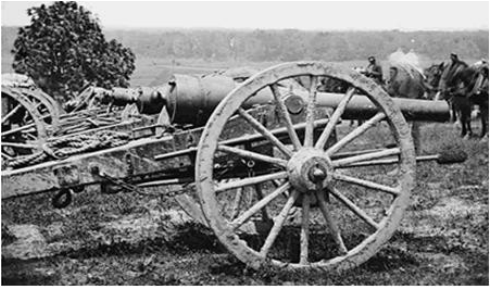
This Smooth bore artillery bursting shell was excavated by the late Bill Jones of Chattanooga. It came out of Missionary Ridge. This projectile was intended for the smoothbore 12 pounder. The fuse employed was a wood time fuse.The fuse hole is smooth and tapered so the simply made fuse could easily be hammered into place, Those with small openings, .875 in., were generally manufactured before the war for the 12 pounder Coehorn Mortar. However by the beginning of the Civil War this small Coehorn mortar had largely been replaced by the newer 24 pounder Coehorn. All of the arsenals would have been abundantly stocked with them, and southerners made good use of them in the 12 pounder howitzers, referred to as the "Napoleon". Those with larger opening, 1.125 in. may have been intended for the longer range Napoleons, however it appears that the size distinction of the opening was of little concern and both sizes were manufactured and extensively used throughout the war. There are also thickness differences in the casting, and many have been designed for "case shot" versus "common", however these shells are seldom found packed with case shot, so the presumption is that the use was "common", standard bursting charge without case shot balls, regardless of thickness of the casting. Perhaps southerners felt they could not spare the case shot balls. Projectile measures: diameter 4.52 in., weight 8 lbs.
(Reference; Dickey & George, Field Artillery (1993 Edition), pg. 30)
REMAINS OF CS SABER FROM NORTH ANNA
The remains of a CS manufactured sword and scabbard with the lapsed seam and unique sand cast brass drag. It came with a plastic tag that reads " Confederate Sword Relic--Found along the bank of the North Anna River in Hanover County, Virginia, these remains of a Confederate cavalry saber and its brass-drag scabbard bear silent witness to the dramatic activities which occurred in that vicinity during the War Between the States."
(Reference; "Civil War Artifacts A Guide to The Historian" by Howard Crouch, page 83)
(Reference; "Civil War Artifacts A Guide to The Historian" by Howard Crouch, page 83)
CONFEDERATE FRICTON PRIMER
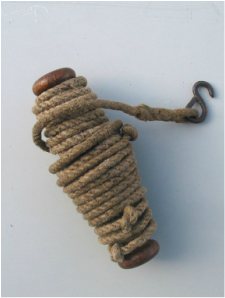 CANNON LANYARD
CANNON LANYARD
Confederate Friction Primer with certificate from Mr. Charles Harris. These were put together back in 1983 and acquired by Mr. Lawrence Christopher of Dalton, GA. Lawrence stated that he was in the same relic club as Charles Harris and purchased all of these primers that were available. Lawrence said he went to Augusta and saw one of the scuba divers and purchased a whole truck load of items that came out of the river including pieces of Rail from the Augusta Arsenal that no one wanted. There were also lots of shells and other Civil War items that came out of the river. The certificate reads " This Confederate Friction Primer was recovered from the Savannah River at the site of the Augusta Arsenal by scuba divers, Andy & Lynn Thompson & Alan Marshal during the 1981-82 diving seasons. This is part of the great Augusta Arsenal cache that was dumped into the river at the site of the McLean house in early 1864." The card dates to the 1980's and has the signature of one of the best known authorities on dug relics. Charles Harris signed several of these certificates shortly after the cash of these primers were found. The primer is in very good condition and is complete.There were four sizes of friction primers recovered. Friction primers were used with a lanyard to fire the cannons. The gunner would insert this brass tube into the vent hole of the cannon, a lanyard attached to the ring would be pulled sending a spark into the powder chamber to ignite the firing. This short pattern was used for field guns.
Reference:"The Illustrated History of American Civil War Relics" by Stephen W. Sylvia & J. O'Donnell, page 102)
Reference:"The Illustrated History of American Civil War Relics" by Stephen W. Sylvia & J. O'Donnell, page 102)
CONFEDERATE ARTILLERY FUSE
Confederate brass fuse adaptor found near the Battle of Cold Harbor in Hanover County Virginia. Local digger found this fuse while hunting on private property with permission. This is an excellent Confederate projectile fuse of the type that is used in the tall Confederate projectiles such as the Read and the Mullane. It is made of copper and it has a nice green patina. It is not bent and there are no "hits" on it. The threads are perfect and it could be screwed into a projectile. A map sowing the location of the find was included with the purchase. The bullets were dug at Cold Harbor too and also came with a map showing the location of the find.
C.S. SPUR
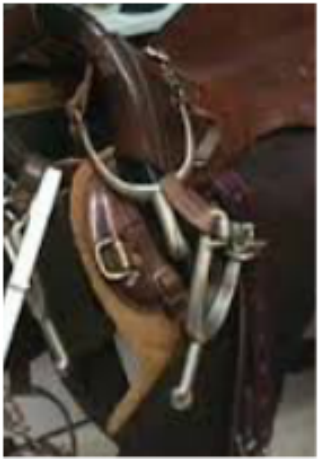
This spur was dug out of Grierson's Raiders camp at Clinton Port Hudson Railroad by Warren Densmore of "Johnny Rebs Relics". The spur is Confederatte Mfg. One arm was bent out when I purchased it from Lawrence of Dalton. I closed my eyes, hoped for the best, and successfully moved the arm back to its original position. Lawrence sent along his certificate with the spur.
"Colonel Benjamin Henry Grierson commanded a brigade of cavalry at Port Hudson under General Bank's command.One of Grierson's main goals was the defeat and elimination of the Confederate cavalry forces under the command of Colonel John Logan, which operated outside the Port Hudson garrison throughout the siege. Logan's men harassed the Union troops from the rear, attacked supply wagons, and were otherwise a major nuisance to Banks. There were repeated skirmishes between the two cavalry units, but none decisive. On June 3rd, Grierson led 1,300 men supported by eight cannon toward Clinton, determined to finish the Confederate cavalry. Logan was alerted and a battle ensued, resulting in Grierson's forces being defeated and forced to retreat back to Port Hudson. Banks then sent General Paine with a powerful force of infantry, cavalry, and artillery back to crush Logan, but the Confederates had escaped."
Reference; Civil War Artifacts, A Guide to The Historian by Howard R. Crouch, page 122; "Civil War Relics of the Western Campaigns" by Charles S. Harris, page 27, 241; "Excavated Artifacts from Battlefields and Campsites of the Civil War 1861-1865" by Stanley S. Phillips, pages 74-76)
SPRINGFIELD LOCKPLATE
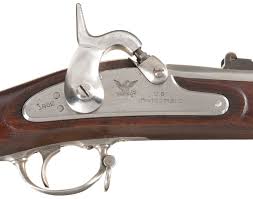
Dug lock plate for a model 1861 Springfield musket. The Model 1861 was the standard rifle-musket used throughout the war. It was originally made by the Springfield Armory, but due to the need for more firearms, the U.S. government contracted with twenty private contractors. It is estimated that about one million Model 1861–type muskets were manufactured during the war. It was a modification of the Model 1855 rifle-musket that eliminated the patch box and the Maynard tape primer. These changes lowered its manufacturing costs and time, both of which were beneficial to a country at war and in need of firearms.
(Reference: "Civil War Artifacts A Guide to The Historian" by Howard Crouch, page 89; "Civil War Relics of the Western Campaigns" by Charles S. Harris, page 89, 196; "Excavated Artifacts from Battlefields and Campsites of the Civil War 1861-1865" by Stanley S. Phillips, page 175)
RICHMOND NOSE CAP
A southern manufactured nose cap noticeably cruder than the federal caps. They are basically a copy of the model1855 that was taken from Harpers Ferry. Some of the 1855 nose caps had one single stud. When the Confederates ran out of those they made a crude copy with a single screw hole such as this one making it easily identified as Confederate. It fits very nicely on the Richmond carbine I own but it has the ground action and patina of a dug item. I purchased this with the 12" section of barrel dug with the nose cap in Virginia.
CORINTH SHILOH RELICS
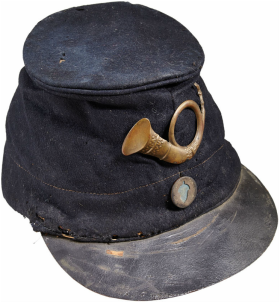
Small but interesting remnants of the heavy fighting in the Corinth and Shiloh areas. Included are a pieces of hat pins, and buckle and breast plate remnants. Most of these were dug by the late Mr. Stan Hughes of Corinth or friends of his.The Corinth railway tracks still cross in the center of town, and trains still use them but no one fights over them any more. During the Civil War as many as 300,000 soldiers moved through this tiny town in northeastern Mississippi as the Union and the Confederacy fought to control the critical railroad crossover. The evidence of their presence is everywhere. A reconstructed earthen commemorates the men in grey who marched with slow and steady steps against its walls and the men in blue who defended it in fierce hand-to-hand combat. And if you look carefully, you can see miles and miles of earthen fortifications, some built to protect the crossover and some to help seize it. These trenches testify to a new kind of warfare that was tested here and would become common before the war ended in 1865.
(Reference; Civil War Artifacts, A Guide to The Historian by Howard R. Crouch, pages 37, 151,152; "Excavated Artifacts from Battlefields and Campsites of the Civil War 1861-1865" by Stanley S. Phillips, pages 91-93)
(Reference; Civil War Artifacts, A Guide to The Historian by Howard R. Crouch, pages 37, 151,152; "Excavated Artifacts from Battlefields and Campsites of the Civil War 1861-1865" by Stanley S. Phillips, pages 91-93)
IRON BULLET MOLD

This is an Iron bullet mold for Colt 44 cal. pistol with the spur cutter still on. Relic condition but able to open and close. The actual process of making bullets did not differ much from the way musket balls had been made in the decades preceding the war. Bullets were still made from soft lead, a metal that melted much more easily than most substances available to the soldiers and factories. Both the North and South used a series of bullet molds that could be easily filled and fitted with the melted lead. The lead itself was harvested from used bullets, ingots created from mining operations or some types of scrap metal, and melted in large iron vats that would withstand the heat that the lead could not. Once sufficiently liquid, the lead was poured into the molds, which were made from iron, stone or ceramic pieces.
The molds themselves not only made the lead harden into general shapes, but also added bands or ridges to some bullets that were designed to help the bullet fit better in the barrel of the gun and spin more accurately when they were fired. Some bullets were stamped with a logo of the manufacturer or the army using them. Once the lead had cooled, the molds were unclamped and the bullets popped out, making room for the next series. Sometimes the molds were dunked in vats of water to speed the cooling process, a stage more common to factories than on-site bullet manufacturing. Many soldiers in the Civil War made their own bullets by harvesting spent rounds and cooking them over fires until they could be poured into portable molds.
(Reference; Civil War Artifacts, A Guide to The Historian by Howard R. Crouch, page 104; "Excavated Artifacts for Battlefields and Campsites of the Civil War" by Stanley S. Phillips 1861-1865", page 166-168)
STARTER KITS
It's very easy and affordable to start collecting Civil War. Items similar to these are authentic, plentiful and can be assembles for a few dollars. Their historical representation of those times are just as significant as artifacts that demand thousands of dollars. The first ryker box above contains a leather grommet, a button back, a dropped union bullet, a flat button, and a fired three ringer. The bottom ryker box contains a 54 cal Sharps carbine bullet, a bayonet scabbard tip, a Gallagher carbine, a saddle buckle and a canister shot.
